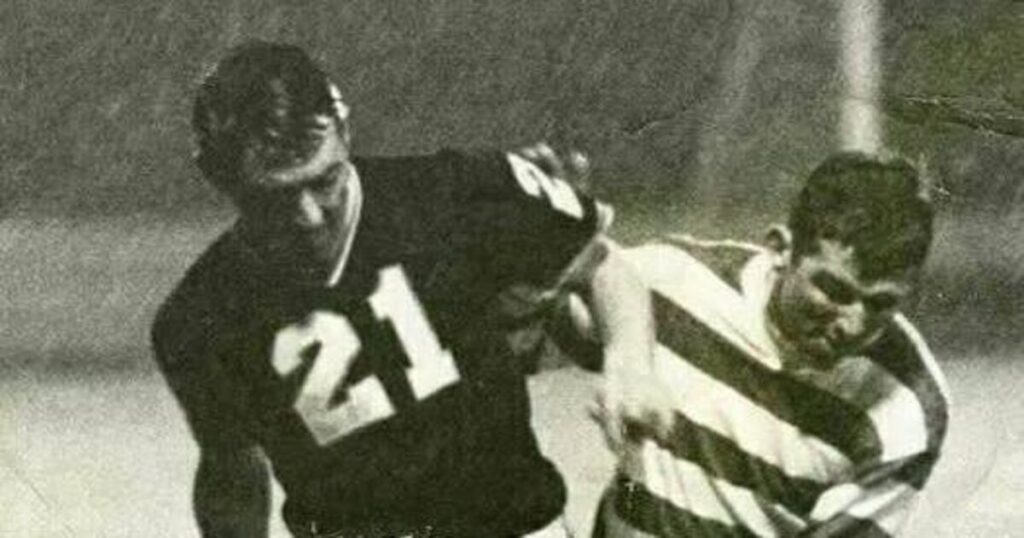I think it is fair to say that football has finally taken off in the United States. With a World Cup on the horizon and steadily increasing attendances, the sport that always eluded the adoration of the US sporting community has begun to embed itself in the culture of young sports fans across the Atlantic.
A lot of effort and some strange ideas have gone into the countless attempts by different individuals to get the world’s most popular sport into the heart of the US public. There has always been a very American approach to the philosophy around growing the sport in the US. Get the big stars in and surround them with pageantry and hype and the celeb-crazed American public will lap it up. In 2025 it is Lionel Messi, in 2007 it was David Beckham. Some people of a certain vintage will remember in the 70s when it was Pele. However, in the 1960s it was Shamrock Rovers.
Well, not quite, but stay with me.
Following the fanfare around England’s 1966 World Cup triumph, there was a growing interest in the US around building a professional football league in a country where the sport barely registered with the general public. Two rival football associations emerged – The National Professional Soccer League (NPSL) and the United Soccer Association(USA).
The United Soccer Association, otherwise known as The USA (confusing, I know) took an audacious shortcut to build up their league and their credibility. Instead of spending years registering teams, building squads and recruiting players they decided to import entire clubs from Europe and South America and gave them new identities in order to kickstart their new league.
Some recognisable names set sail to the United States for the inaugural USA League in 1967 including Wolverhampton Wanderers, Aberdeen, Cagliari and Shamrock Rovers. Teams were renamed and placed in a city relevant to them which led to Shamrock Rovers being stationed in Boston due to Boston’s large Irish community. They were renamed “Boston Rovers”.
“Going to the States in the sixties was fantastic,” according to Mick Leech, the Shamrock Rovers legend who was just 20 when he boarded that transatlantic flight. “Dublin and Ireland at the time was a dreary, gloomy place. The whole trip was Disneyworld.”
Rovers played their home games in the Manning Bowl in Lynn, a suburb 10 miles out of downtown Boston. It was a baseball stadium that was not necessarily decked out for soccer due to its square playing surface. Around 7,000 spectators went to see Rovers nab a 1-1 draw in their opening game on May 28 against the Detroit Cougars, better known to you and I as Glentoran FC from Belfast. The following week saw a 3-1 victory over the Houston Stars but things quickly went downhill after that and positive results on the pitch were few and far between. Rovers suffered a heavy 5–0 defeat to the Chicago Mustangs and a 4-1 loss to Dallas Tornados.
The glamour of a trip abroad to America would not have been complete without a few celebrity encounters. Leech talks about an encounter with a young musician in an elevator in Toronto who turned out to be a 17-year-old Stevie Wonder. The squad also met with Maureen O’Hara, the Irish film icon from Dublin who was a diehard Rovers fan her entire life.
Boston Rovers finished dead last in the league with two wins, three draws and seven losses. At the same time the whole project was failing quite spectacularly. “They were interested in promoting soccer, but it was a business situation,” Leech says. “The crowds were poor, there was no money to be made.” The players began to notice the quality of their food and accommodation diminishing as well as their spending money being reduced.
The league received modest coverage in the American press but was basically not reported on at all back home in Ireland.
The plug was pulled and the project was over only a couple of months after it had begun. Of the 12 teams who competed in the league, only the Dallas Tornados (Dundee United) would exist to see the beginning of the next decade.
In 1968, the USA and NPSL merged into the North American Soccer League which would later use the same guiding principals to draw in global stars such as Pele, Cryuff and Beckenbauer. The Rovers squad returned home to Dublin and the Boston Rovers renamed themselves the Boston Beacons before folding one year later.
In hindsight, it was always unlikely that a country with no interest in football was going to have its passion for the sport ignited and set ablaze by the likes of Shamrock Rovers and Stoke City, but the efforts of the USA league was the first attempts of a tactic that would remain as a means to increasing the sports popularity for decades to come and one which has ultimately worked. In other words, Shamrock Rovers walked so that Inter Miami could run.
Though there were few great on-field moments or iconic games to talk about, it was an opportunity for young Dublin footballers such as Mick Leech to travel to America and see the world at a time when this was unaffordable to most. It also gave somewhat of an international reputation to clubs like Shamrock Rovers and, who knows, maybe there’s a few fifth generation Irish Americans who retained their interest in the hoops long after Boston Rovers were gone.


